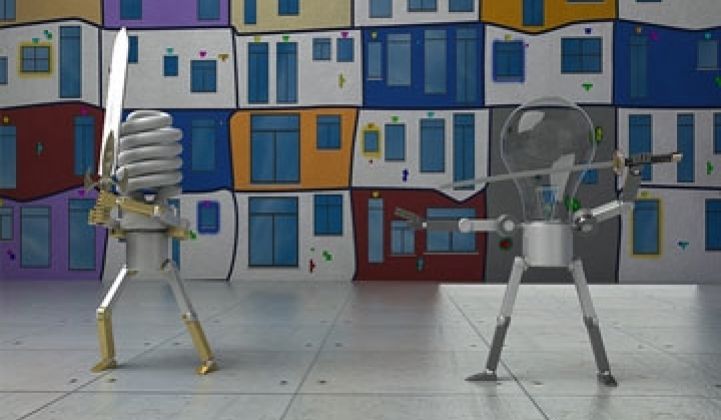Philips, the largest light manufacturer in the world, said it will come out with a light emitting diode (LED) bulb that will consume about 12 watts but emit 806 lumens, or as nearly much light as a 60-watt incandescent bulb.
The bulb will also be dimmable, emit a warm white light, and come out commercially toward the end of 2010.
If Philips can meet its deadline, it will one-up General Electric. GE announced a 40-watt equivalent LED bulb last week that only puts out 450 lumens of warm white light. It comes out in 2011. Philips dethroned GE in lighting a few years ago through a few large acquisitions.
Philips submitted a bulb in 2009 for the L Prize sponsored by the Department of Energy. The L Prize will give an award to the inventor or company that can devise a 60-watt equivalent that uses 10 watts of energy or less and sports an efficiency of 90 lumens per watt. An L prize winner also needs to emit a minimum of 900 lumens. This bulb falls a little short of that, but contest entrants tend to be a little more rarefied than your mass-produced items.
The rush to replace traditional light bulbs is in full swing. Regulations, declining prices and the improved quality of LED bulbs are ushering in an era of solid-state lighting. Australia has already imposed regulations that effectively ban incandescent bulbs and the European Union will follow suit in 2012. The U.S. has imposed efficiency regulations that will ultimately push the incandescent to the margins by 2014. Canada, the Philippines, and others have similar plans.
Like Philips and GE, Osram, Toshiba, Panasonic and startups like Bridgelux and Renaissance Lighting hope to capitalize on these trends by readying LED bulbs for offices and homes. Expect to see more activity for offices first. Philips, in fact, will target its light at commercial customers initially. Because they last longer, LEDs don't need to be replaced as often, which reduces maintenance costs. Thus, the payoff is likely to be quicker for commercial users.
Another benefit of LEDs: colors. Osram will add color accents to upcoming home LED lights for an aesthetic effect.
Along with bulb makers, companies like Redwood Systems and Adura Technologies are creating networking systems to automatically control lights and thereby save energy. All those lights you see twinkling in a picturesque urban skyline at night? Typically, no one is even occupying most of those offices. Lighting consumes 22 percent of the electricity in the U.S. -- and a lot of it gets wasted.
But there are a few speed bumps along the way. First, the price. GE's bulb will cost $40 to $50. Panasonic has a 60 watt equivalent in Japan for $50 to $60. Philips isn't talking prices yet. LED bulbs can save $12 or more a year in power bills and the bulbs can last ten years or more, so they pay for themselves. Philips says its 60 watt equivalent bulb will save owners 20 Euros a year, an estimate somewhat on the high side, and last 25,000 hours, again on the high side. Still consumers and even consumer customers will likely balk at the price.
The quality of light remains an issue too. Although the clinical, bluish "Alien Autopsy" shade of older LED bulbs has vanished, LED bulbs can be a bit dimmer than traditional bulbs. We tested a Lemnis Lighting bulb recently -- it emits a nice, warm, white light but not as much of it as a standard bulb. The word-of-mouth on all of these bulbs will be a big issue and will help determine winners and losers.
Bulb makers will also increasingly sell lamps and other fixtures along with their bulbs. Why? Because LED lights last for years, the replacement market will be awfully small.



